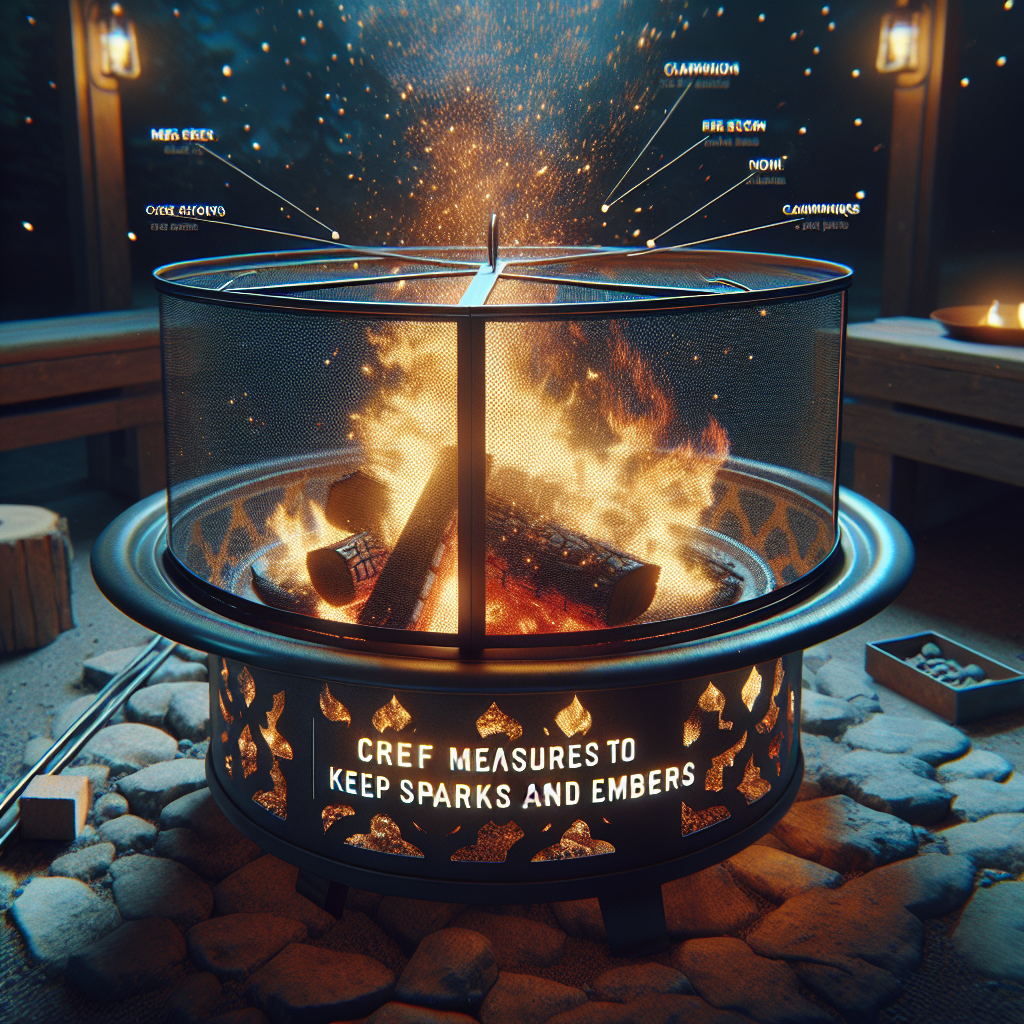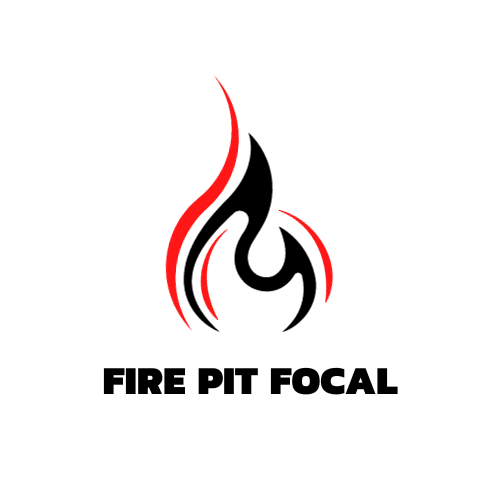If you love spending evenings gathered around a cozy fire pit, you may have encountered a common issue: the escape of sparks and embers. Not only can these escaping particles pose a safety risk, but they can also be quite bothersome. Fortunately, there are a few simple and effective methods to prevent sparks and embers from escaping your fire pit. By implementing these measures, you can enjoy your outdoor fires without the worry of potential hazards or annoying burns.
Proper Fire Pit Construction
Choose a Safe Location for the Fire Pit
When constructing a fire pit, the first and foremost thing to consider is its location. You want to ensure that your fire pit is placed in a safe and suitable area. Choose a location that is away from any flammable materials such as overhanging trees, low-hanging branches, shrubs, or dried grass. It is also important to consider the proximity of your fire pit to structures like your house, garage, or wooden decks. The ideal location should have a clear and open space around it, providing ample room for people to gather without any potential hazards.
Build a Fire Pit with a Screen or Spark Guard
To prevent sparks and embers from escaping your fire pit, it is essential to build it with a screen or spark guard. These accessories act as a protective barrier around the fire, preventing sparks from flying out and potentially igniting nearby flammable objects. A screen or spark guard should be made of a durable and heat-resistant material, such as steel or tempered glass. Make sure the screen or spark guard is properly fitted and secured to the fire pit to ensure optimal safety.
Ensure the Fire Pit has Adequate Clearance
Another critical aspect of fire pit construction is ensuring adequate clearance. Your fire pit should have enough space around it to prevent accidental fires and injuries. The general rule of thumb is to maintain a minimum clearance of at least 10 feet from any structures, including your house, fences, or outbuildings. This distance will help minimize the risk of fire spreading and ensure that everyone can enjoy the fire pit comfortably and safely.
Use Fire-Resistant Materials
Using fire-resistant materials when constructing your fire pit is of utmost importance. Common fire-resistant materials include stone, brick, and metal. Avoid materials such as wood or plastic, as these can easily become a hazard when exposed to high temperatures. Fire-resistant materials not only provide durability but also help contain the fire and prevent any accidental ignitions. This is especially important when dealing with wood-burning fire pits, as the intense heat can cause damage if not properly managed.
Keep the Fire Pit Clean and Free of Debris
Regularly cleaning and maintaining your fire pit is a crucial step in ensuring its safety and longevity. Remove any ashes, debris, or leftover wood from previous fires before starting a new one. This will prevent the accumulation of flammable materials and keep the fire contained within the pit. Cleaning your fire pit also helps prevent embers from causing accidental fires when they come in contact with debris outside the pit. Additionally, a clean fire pit is more visually appealing and creates a safer environment for you and your guests to enjoy.
Using Fire-Resistant Accessories
Use a Fire Pit Mat
When using a fire pit on a wooden deck or patio, it is vital to protect the surface from heat damage. A fire pit mat acts as a shield between the fire and the ground, preventing any direct contact and potential fire hazards. Fire pit mats are typically made of fire-resistant materials like fiberglass or silicone, which can withstand high temperatures. Place the mat underneath the fire pit to provide an additional layer of protection and peace of mind.
Install a Fire Pit Heat Shield
In some cases, using a fire pit mat might not be feasible or sufficient to protect the surrounding area. In such situations, installing a fire pit heat shield can be a practical alternative. A heat shield is designed to deflect and dissipate the heat generated by the fire, preventing it from causing damage to nearby structures or objects. Heat shields are typically made of metal and are attached to the back or sides of the fire pit. Additionally, they provide a visually appealing and decorative element to your fire pit setup.
Use Fireproof Gloves
When tending to your fire pit, it is crucial to protect yourself from burns and injuries. fireproof gloves are designed to withstand high temperatures, allowing you to safely handle hot surfaces and objects. These gloves are typically made of materials like leather or Kevlar, which provide excellent heat resistance. By wearing fireproof gloves, you can confidently add or adjust logs, move screens or spark guards, and handle any maintenance tasks without the risk of burns.
Consider a Fire Pit Wind Guard
Strong winds can significantly affect the performance of your fire pit, causing flames to flicker and embers to scatter. To create a more controlled and enjoyable fire experience, consider using a fire pit wind guard. These guards are typically made of tempered glass or metal, and they enclose the fire pit, protecting it from the wind. A wind guard not only prevents embers from escaping but also helps to maintain a consistent flame and heat output.
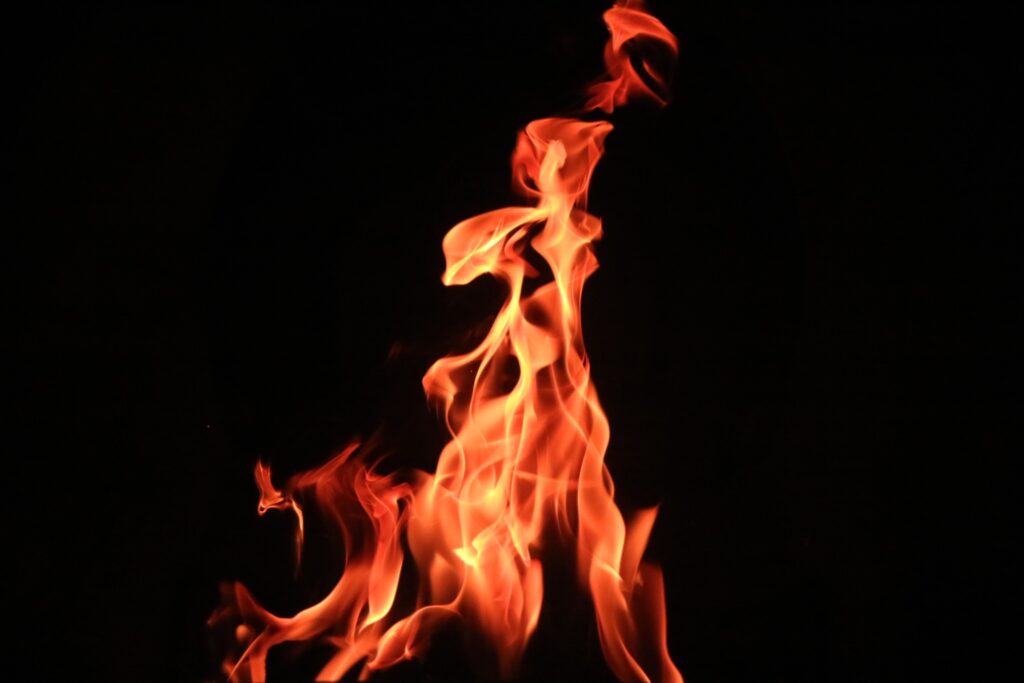
Creating a Fire-Safe Environment
Clear the Surrounding Area
Before lighting your fire pit, it is essential to clear the surrounding area of any potential fire hazards. Remove dry leaves, twigs, or other flammable materials that may be in close proximity to the fire pit. By keeping the area clean and clear, you reduce the risk of accidental fires and ensure that the fire remains contained within the pit. Regularly inspect the area before each use and remove any debris that may have accumulated since the last fire.
Keep Flammable Items Away
To prevent any accidental fires or injuries, it is crucial to keep flammable items away from your fire pit. Items such as lighter fluid, gasoline, or propane tanks should be stored in a safe location, away from the fire pit. Avoid placing flammable materials like paper, cardboard, or wood near the fire pit. Any loose clothing or blankets should also be kept a safe distance away from the flames to avoid potential accidents.
Trim Nearby Trees and Branches
If your fire pit is located under or near trees, it is important to regularly trim back branches and foliage to create a safe distance. Overhanging trees or branches can catch fire easily, especially when there are sparks or embers present. Keeping trees and branches adequately pruned minimizes the risk of accidental fires and ensures the safety of both the fire pit area and the surrounding landscape. Consult with a professional arborist if you need assistance with tree trimming.
Maintain a Safe Distance from Structures
When setting up your fire pit, ensure there is a safe distance between the fire and any structures, such as your house, garage, or wooden decks. The heat generated by the fire can cause damage to these structures and pose a fire hazard. Follow the manufacturer’s recommendations for minimum clearance distances, and be mindful of any local regulations or building codes that may dictate specific requirements. By maintaining a safe distance, you can enjoy a cozy fire without compromising safety.
Proper Fire Pit Maintenance
Regularly Inspect and Replace Screens or Spark Guards
To ensure the ongoing safety and functionality of your fire pit, it is important to regularly inspect and maintain the screens or spark guards. Over time, these accessories may become worn, damaged, or corroded. Inspect them before each use to ensure they are in good condition and free from any holes or gaps. If any issues are detected, replace the screens or spark guards promptly to maintain optimal safety standards.
Remove Ashes and Debris
After each use, it is crucial to remove ashes and debris from your fire pit. Use a metal shovel or scoop to carefully scoop out the ashes and transfer them to a metal bucket. Allow the ashes to cool completely before disposing of them in an appropriate manner. Never dispose of hot ashes in plastic or flammable containers, as they can potentially ignite. Cleaning out the ashes not only prevents the buildup of flammable materials but also helps maintain the longevity of your fire pit.
Monitor and Extinguish the Fire Completely
Never leave a fire pit unattended, especially when there are still flames or embers present. It is essential to monitor the fire until it has completely extinguished. Use a long-handled poker or tongs to carefully stir and spread out the remaining embers. Once the fire has been fully extinguished, pour water over the embers to ensure they are fully cooled. It is crucial to wait until all the ashes are cold and no longer smoldering before leaving the fire pit unattended.
Store Firewood Properly
If you use firewood in your fire pit, proper storage is key to prevent potential hazards. Keep your firewood stacked in a dry and well-ventilated area, away from any flammable materials. It is essential to store firewood at a safe distance from your house, garage, or any other structures. Avoid storing firewood directly next to your fire pit, as it can increase the risk of accidental fires. When using firewood from storage, inspect it for any signs of moisture, mold, or rot, as these can create excessive smoke and compromise safety.
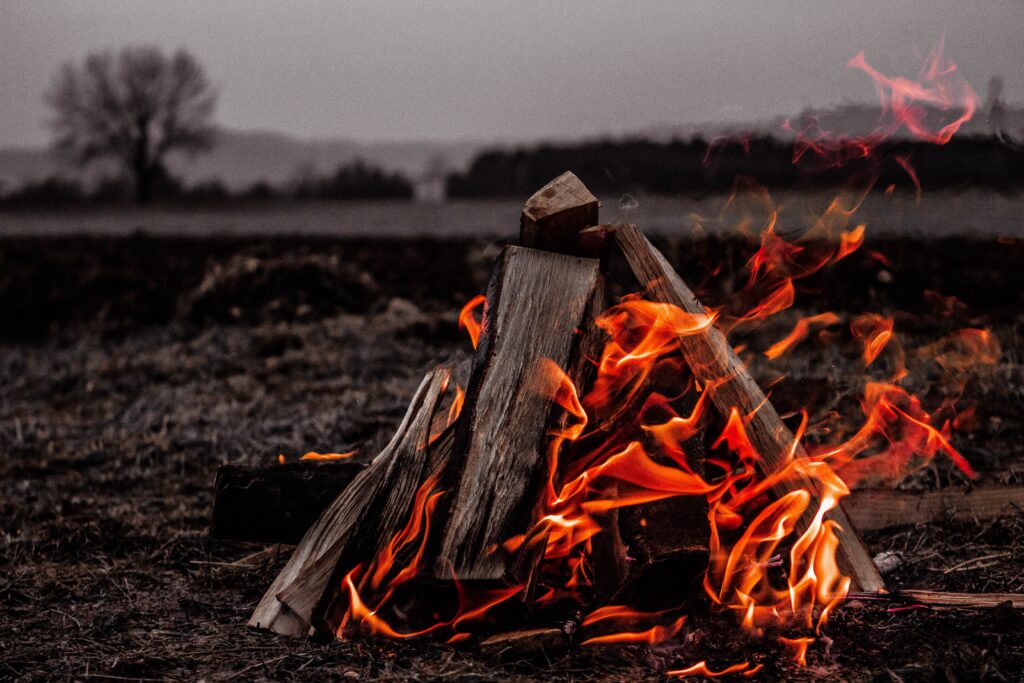
Alternative Fire Pit Options
Consider a Gas Fire Pit
While traditional wood-burning fire pits are popular, gas fire pits offer an alternative option with their convenience and safety features. Gas fire pits operate using propane or natural gas, eliminating the need for firewood and reducing the risk of sparks and embers. They provide adjustable flames and can be easily turned on and off with a switch or dial. Gas fire pits also eliminate the hassle of cleaning ashes and debris. However, it is important to follow the manufacturer’s instructions and maintain gas connections properly to ensure safe usage.
Use Fire Glass or Lava Rock
When designing your fire pit, consider using fire glass or lava rock instead of traditional firewood. Fire glass and lava rock are both fire-resistant and provide a visually appealing alternative. Fire glass is made from tempered glass and comes in various colors, adding a modern and stylish touch to your fire pit. Lava rock is a natural volcanic rock that can withstand high temperatures and adds a rustic look to your fire feature. Both fire glass and lava rock do not produce smoke or ashes, making them a low-maintenance and safe choice.
Educating Family and Guests
Teach Children about Fire Safety
When enjoying your fire pit, it is essential to educate children about fire safety. Teach them about the dangers of fire, the importance of keeping a safe distance, and how to behave responsibly around the fire pit. Ensure that children are always supervised by adults when near the fire pit and establish clear rules and boundaries. Encourage them to learn basic fire safety skills, such as the “Stop, Drop, and Roll” technique, in case of an emergency. By instilling these lessons at a young age, you can help create a safe and responsible fire pit environment for everyone.
Warn Guests about Hazards
When inviting guests over to enjoy your fire pit, it is crucial to inform them about any potential hazards and safety guidelines. Clearly communicate the rules and guidelines you have established for the fire pit area. Remind them to keep a safe distance from the flames, not to throw anything into the fire, and to be mindful of their surroundings. Provide information about the location of fire extinguishers and first aid kits, and advise them to familiarize themselves with the emergency procedures in case of an accident. Open communication and awareness can help prevent accidents and ensure a pleasant fire pit experience for everyone.
Establish Fire Pit Rules and Guidelines
To promote safety and responsible usage, it is important to establish fire pit rules and guidelines for all users. Develop a set of rules that outline expectations and behaviors when using the fire pit. Some common rules may include not leaving the fire pit unattended, not using flammable liquids to start or enhance the fire, and not throwing any objects into the fire. Ensure that these rules are clearly communicated and posted near the fire pit for easy reference. By setting clear expectations, you can maintain a safe and enjoyable fire pit environment for everyone.

Local Fire Pit Regulations
Research Local Fire Pit Regulations
Before constructing or using a fire pit, it is essential to research and understand the local fire pit regulations in your area. Local municipalities may have specific rules and guidelines regarding fire pit construction, location, fuel types, and usage. These regulations are implemented to ensure public safety and prevent hazards. Contact your local fire department or visit your city’s official website to obtain accurate information about fire pit regulations. By adhering to these regulations, you can avoid potential fines and penalties while enjoying your fire pit responsibly.
Obtain Necessary Permits or Approvals
In some cases, you may be required to obtain permits or approvals before building or using a fire pit. This can vary depending on your location and the type of fire pit you plan to install. Permits typically ensure that your fire pit meets safety standards and complies with local regulations. Contact your local government authorities or fire department to inquire about the permit requirements and application process. Obtaining the necessary permits or approvals will give you peace of mind and assurance that your fire pit is legally and safely constructed.
Seeking Professional Advice
Consult with a Fire Safety Expert
If you are unsure about any aspect of fire pit construction or usage, it is advisable to consult with a fire safety expert. These professionals have extensive knowledge and experience in fire safety precautions and can provide valuable guidance tailored to your specific situation. A fire safety expert can assess your intended fire pit location, evaluate potential hazards, and recommend specific safety measures to ensure optimal fire pit safety. Their expertise can help you make informed decisions and minimize the risk of accidents or fires.
Hire a Professional to Design and Build Your Fire Pit
If you prefer a hassle-free and professionally designed fire pit, hiring a professional to handle the construction is a great option. A professional contractor or landscape designer specializing in fire pit installations can ensure that your fire pit meets all safety requirements and is custom-designed to suit your preferences and needs. They possess the necessary knowledge and skills to select suitable materials, handle gas installations (when applicable), and create an aesthetically pleasing fire pit area. By working with a professional, you can confidently enjoy a beautiful and safe fire pit in your outdoor living space.
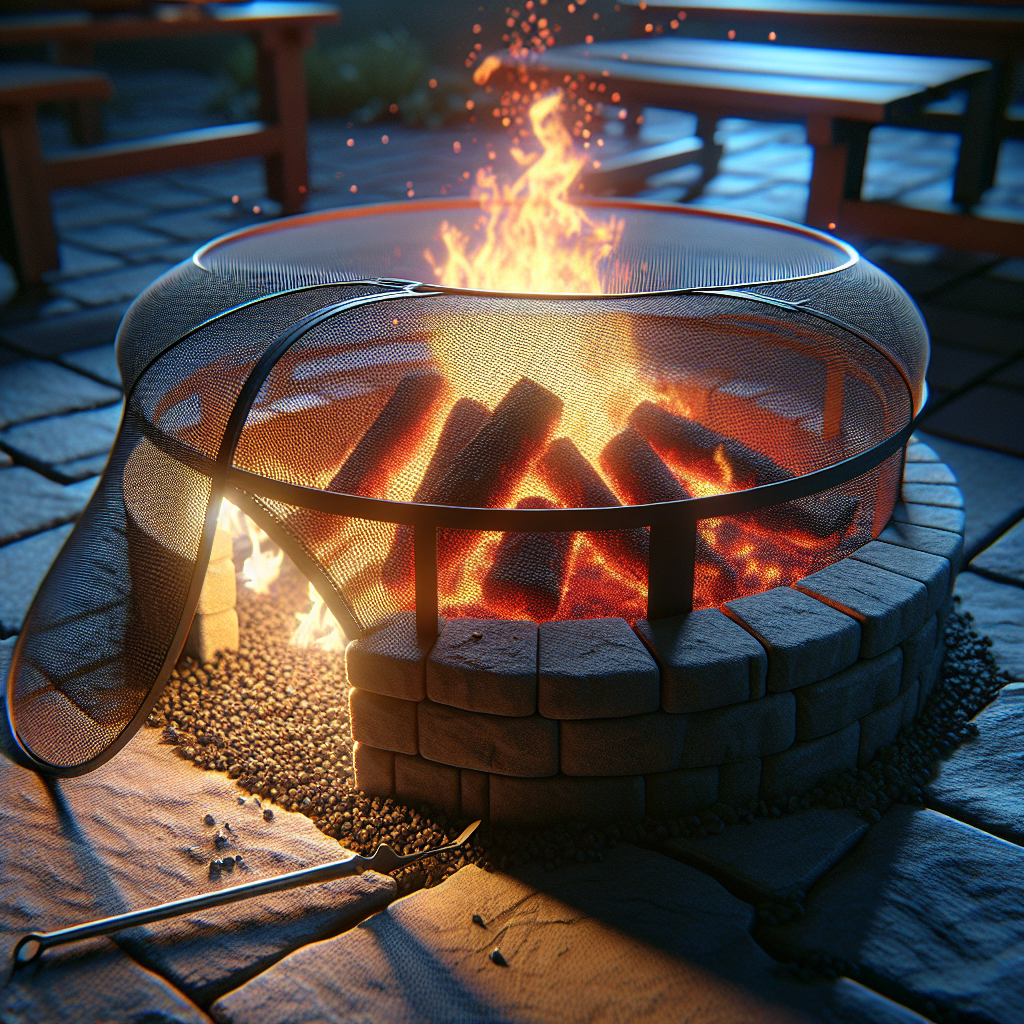
Safety Tips for Fire Pit Usage
Never Leave the Fire Pit Unattended
One of the most important safety tips when using a fire pit is to never leave it unattended. Always ensure that there is a responsible adult present to monitor the fire. Even a small fire can quickly escalate and cause significant damage if left unattended. Assign someone to be in charge of the fire pit during gatherings or parties, and establish a system to ensure that the fire is always supervised. By maintaining constant vigilance, you can prevent potential accidents and quickly address any issues that may arise.
Avoid Using Flammable Liquids
When starting or maintaining a fire in your fire pit, it is crucial to avoid using flammable liquids. Liquids such as gasoline, lighter fluid, or alcohol can quickly ignite and cause unexpected and dangerous flare-ups. Instead, use suitable fire starters, such as newspaper, dry kindling, or fire starter cubes, to ignite the fire safely. Follow the manufacturer’s guidelines and recommendations for using fire starters and avoid overloading the fire with excessive amounts of accelerants. By using proper fire-starting techniques and materials, you can maintain a controlled and safe fire.
Keep a Fire Extinguisher Nearby
Having a fire extinguisher readily available near your fire pit is a vital safety precaution. In case of an emergency or if the fire starts to get out of control, a fire extinguisher can quickly suppress the flames and prevent a potentially catastrophic situation. Choose a fire extinguisher that is suitable for managing different types of fires, including those involving flammable liquids or electrical equipment. Familiarize yourself with the proper operation and maintenance of the fire extinguisher and ensure it is easily accessible to everyone using the fire pit.
Be Cautious with Windy Conditions
Windy conditions can significantly impact the safety and enjoyment of your fire pit. Strong winds can cause flames to fluctuate, embers to scatter, and potentially spread the fire beyond the confines of the fire pit. It is crucial to exercise caution and avoid using the fire pit in excessively windy conditions. If you still wish to use the fire pit, implement additional safety measures such as using a wind guard, selecting a more sheltered location, or reducing the size of the fire. Always be mindful of the changing wind patterns and take necessary precautions to ensure the safety of yourself, your guests, and your surroundings.
Conclusion
Proper fire pit construction and usage are essential to ensure a safe and enjoyable outdoor experience. By following the guidelines outlined in this comprehensive article, you can create a fire pit that prioritizes safety and minimizes the risk of accidents or fires. From choosing a suitable location and using fire-resistant materials to educating your family and guests about fire safety, each step plays a vital role in promoting a culture of responsibility and awareness. Remember to adhere to local regulations, obtain necessary permits, and seek professional advice when needed. By taking these proactive measures, you can confidently cherish the warmth and ambiance of your fire pit while ensuring the well-being of everyone around it.
